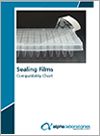Plate Sealing
For Convenient and Easy Microplate Sealing
Microplates are a standard tool in analytical research and clinical diagnostic testing laboratories. They are used in virtually every Life Sciences application as they simplify the handling of large numbers of samples and enable automation.
Since practically every experiment includes incubation and/or necessitates sample storage, it is essential that plates can be securely sealed in order to avoid contamination and evaporation. Several types of sealing systems are available and different techniques and products can be used including adhesive sealed films and foils, sealing mats and plate lids.
Applications
Applications for sealing films mirror the applications for multi-well plates and tissue culture plates that have become ubiquitous in today’s laboratories. These include enzyme-linked immunosorbent assays (ELISAs) and polymerase chain reaction (PCR) methods for amplification of nucleic acids for analysis and quantification, both classic and real-time.
Other films are designed to support manual and robotic processing and storage of samples in high-throughput screening (HTS), to maximise signal to noise in fluorescence and luminescence assays, and to promote uniform gas exchange in cell and tissue culture procedures.
Plate lids offer a temporary closure and are useful when multiple components are to be added to the plate wells as they are easily removed and provide protection against contamination during experiment set-up.
Sealing mats also provide a temporary closure and in addition provide protection against evaporation of samples. Furthermore, they can be autoclaved and re-used if required.

View Products by Application:
Adhesive Films
Adhesive sealed films and foils can offer more permanent sealing and unlike lids and sealing mats which are for general use, films and foils are application based in their design and provide protection against evaporation, condensation, oxidation and cross contamination during processing, storage and shipment. Our application guides can help you choose the right seal for your particular application.
Adhesive seals are easily applied by hand using a sealing roller or paddle, making them ideal for use where smaller numbers of samples are processed. They are also available in roll format for use on sealing machines that can apply pressure without a high temperature for use where samples are heat sensitive and the throughput is high.

Heat Sealed Films
The preferred method for sealing microplates, heat-sealing, creates an airtight chemically-resistant seal without the complications of using adhesives for the application.
Available with application specific features in individual sheets or rolls, our range of heat sealed films are suitable for numerous low, medium & high-throughput needs.

Compatibility
Compatibility between MicroPlate and sealing process and materials is paramount, therefore the appropriate parameters must be understood and the limitations of both sealing options and the plates themselves appreciated.

